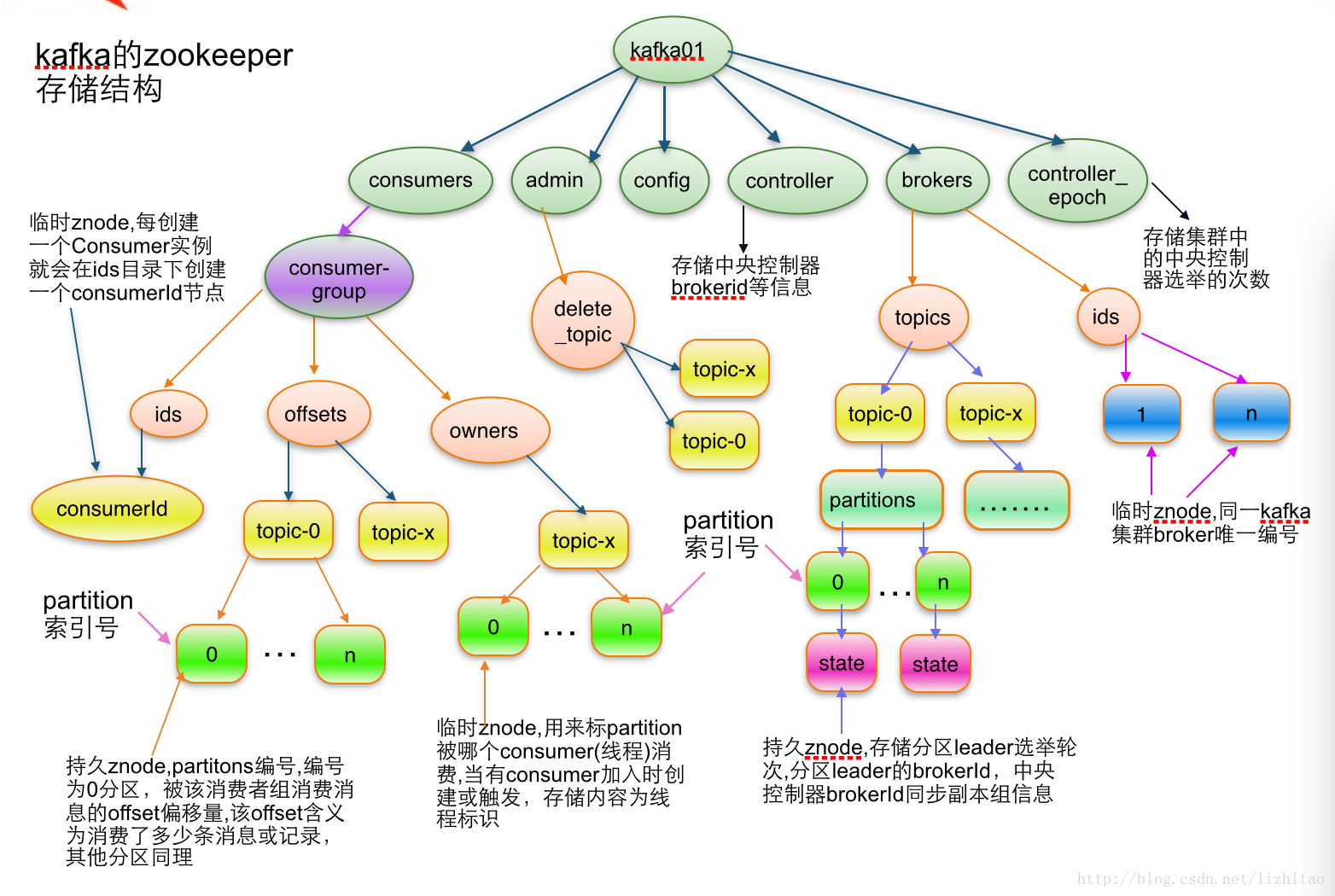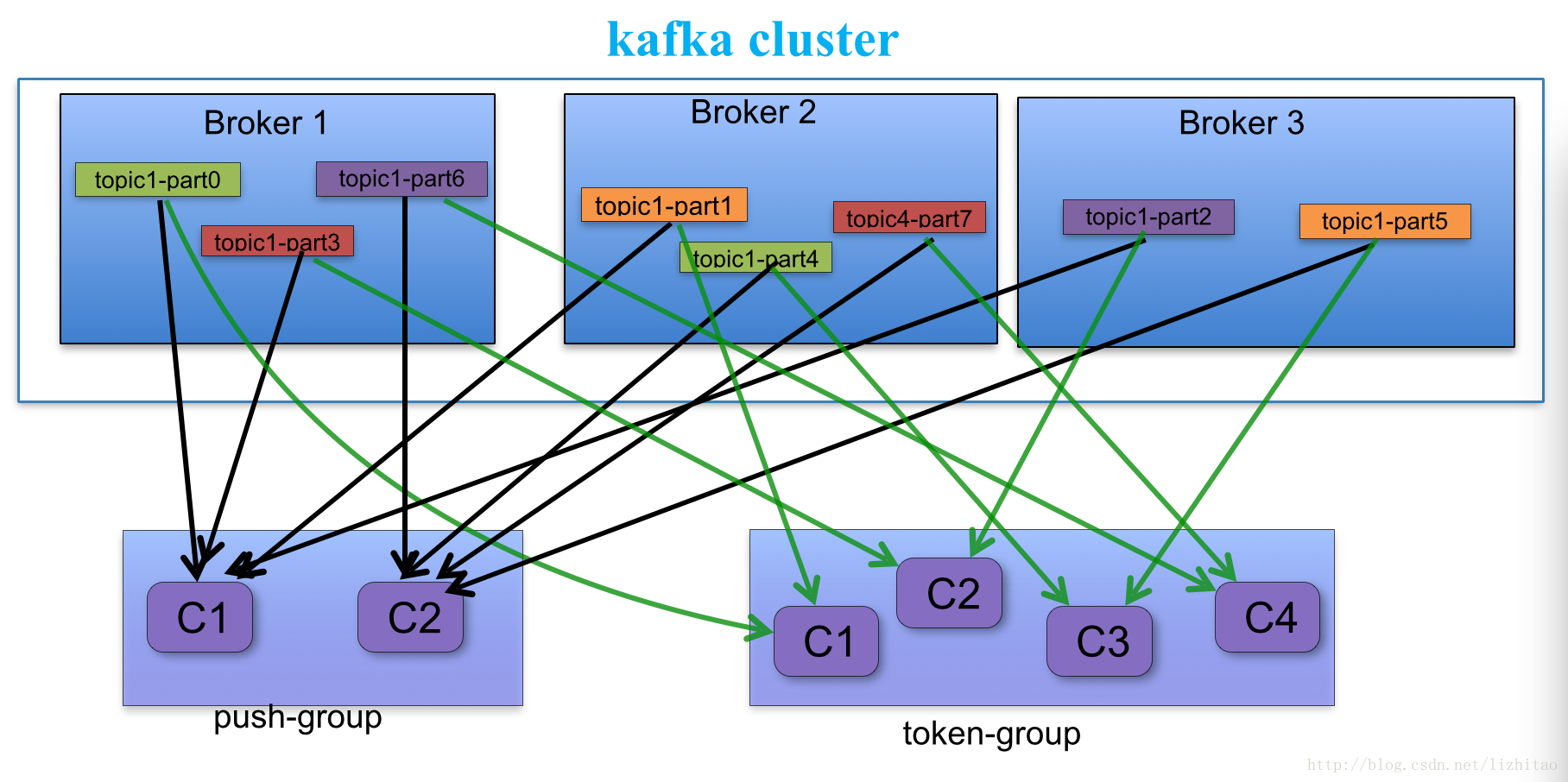首页 > 代码库 > apache kafka系列之在zookeeper中存储结构
apache kafka系列之在zookeeper中存储结构

1.topic注册信息
/brokers/topics/[topic] :
存储某个topic的partitions所有分配信息
Schema:
{ Example:
{ 说明:紫红色为patitions编号,蓝色为同步副本组brokerId列表 |
2.partition状态信息
/brokers/topics/[topic]/partitions/[0...N] 其中[0..N]表示partition索引号
/brokers/topics/[topic]/partitions/[partitionId]/state
Schema:
{ Example:
{ |
3. Broker注册信息
/brokers/ids/[0...N]
每个broker的配置文件中都需要指定一个数字类型的id(全局不可重复),此节点为临时znode(EPHEMERAL)
Schema:
{ Example:
{ "timestamp":"1403061899859" |
4. Controller epoch:
/controller_epoch -> int (epoch)
此值为一个数字,kafka集群中第一个broker第一次启动时为1,以后只要集群中center controller中央控制器所在broker变更或挂掉,就会重新选举新的center controller,每次center controller变更controller_epoch值就会 + 1;
5. Controller注册信息:
/controller -> int (broker id of the controller) 存储center controller中央控制器所在kafka broker的信息
Schema:
{ Example:
{ "version": 1, "brokerid": 3, "timestamp": "1403061802981" }
|
a.每个consumer客户端被创建时,会向zookeeper注册自己的信息;
b.此作用主要是为了"负载均衡".
c.同一个Consumer Group中的Consumers,Kafka将相应Topic中的每个消息只发送给其中一个Consumer。
d.Consumer Group中的每个Consumer读取Topic的一个或多个Partitions,并且是唯一的Consumer;
e.一个Consumer group的多个consumer的所有线程依次有序地消费一个topic的所有partitions,如果Consumer group中所有consumer总线程大于partitions数量,则会出现空闲情况;举例说明:kafka集群中创建一个topic为report-log 4 partitions 索引编号为0,1,2,3假如有目前有三个消费者node:注意-->一个consumer中一个消费线程可以消费一个或多个partition.如果每个consumer创建一个consumer thread线程,各个node消费情况如下,node1消费索引编号为0,1分区,node2费索引编号为2,node3费索引编号为3总结 :如果每个consumer创建2个consumer thread线程,各个node消费情况如下(是从consumer node先后启动状态来确定的),node1消费索引编号为0,1分区;node2费索引编号为2,3;node3为空闲状态
从以上可知,Consumer Group中各个consumer是根据先后启动的顺序有序消费一个topic的所有partitions的。如果Consumer Group中所有consumer的总线程数大于partitions数量,则可能consumer thread或consumer会出现空闲状态。
Consumer均衡算法
当一个group中,有consumer加入或者离开时,会触发partitions均衡.均衡的最终目的,是提升topic的并发消费能力.
1) 假如topic1,具有如下partitions: P0,P1,P2,P3
2) 加入group中,有如下consumer: C0,C1
3) 首先根据partition索引号对partitions排序: P0,P1,P2,P3
4) 根据(consumer.id + ‘-‘+ thread序号)排序: C0,C1
5) 计算倍数: M = [P0,P1,P2,P3].size / [C0,C1].size,本例值M=2(向上取整)
6) 然后依次分配partitions: C0 = [P0,P1],C1=[P2,P3],即Ci = [P(i * M),P((i + 1) * M -1)]
6. Consumer注册信息:
每个consumer都有一个唯一的ID(consumerId可以通过配置文件指定,也可以由系统生成),此id用来标记消费者信息.
/consumers/[groupId]/ids/[consumerIdString]
是一个临时的znode,此节点的值为请看consumerIdString产生规则,即表示此consumer目前所消费的topic + partitions列表.
consumerId产生规则:
StringconsumerUuid = null;
if(config.consumerId!=null && config.consumerId)
consumerUuid = consumerId;
else {
String uuid = UUID.randomUUID()
consumerUuid = "%s-%d-%s".format(
InetAddress.getLocalHost.getHostName, System.currentTimeMillis,
uuid.getMostSignificantBits().toHexString.substring(0,8));
}
String consumerIdString = config.groupId + "_" + consumerUuid;
Schema:
{ Example:
{ "version": 1, "subscription": { "open_platform_opt_push_plus1": 5 }, "pattern": "static", "timestamp": "1411294187842" } |
7. Consumer owner:
/consumers/[groupId]/owners/[topic]/[partitionId] -> consumerIdString + threadId索引编号
当consumer启动时,所触发的操作:
a) 首先进行"Consumer Id注册";
b) 然后在"Consumer id 注册"节点下注册一个watch用来监听当前group中其他consumer的"退出"和"加入";只要此znode path下节点列表变更,都会触发此group下consumer的负载均衡.(比如一个consumer失效,那么其他consumer接管partitions).
c) 在"Broker id 注册"节点下,注册一个watch用来监听broker的存活情况;如果broker列表变更,将会触发所有的groups下的consumer重新balance.
8. Consumer offset:
/consumers/[groupId]/offsets/[topic]/[partitionId] -> long (offset)
用来跟踪每个consumer目前所消费的partition中最大的offset
此znode为持久节点,可以看出offset跟group_id有关,以表明当消费者组(consumer group)中一个消费者失效,
重新触发balance,其他consumer可以继续消费.
9. Re-assign partitions
/admin/reassign_partitions
{
"fields":[
{
"name":"version",
"type":"int",
"doc":"version id"
},
{
"name":"partitions",
"type":{
"type":"array",
"items":{
"fields":[
{
"name":"topic",
"type":"string",
"doc":"topic of the partition to be reassigned"
},
{
"name":"partition",
"type":"int",
"doc":"the partition to be reassigned"
},
{
"name":"replicas",
"type":"array",
"items":"int",
"doc":"a list of replica ids"
}
],
}
"doc":"an array of partitions to be reassigned to new replicas"
}
}
]
}
Example:
{
"version": 1,
"partitions":
[
{
"topic": "Foo",
"partition": 1,
"replicas": [0, 1, 3]
}
]
}
|
10. Preferred replication election
/admin/preferred_replica_election
{
"fields":[
{
"name":"version",
"type":"int",
"doc":"version id"
},
{
"name":"partitions",
"type":{
"type":"array",
"items":{
"fields":[
{
"name":"topic",
"type":"string",
"doc":"topic of the partition for which preferred replica election should be triggered"
},
{
"name":"partition",
"type":"int",
"doc":"the partition for which preferred replica election should be triggered"
}
],
}
"doc":"an array of partitions for which preferred replica election should be triggered"
}
}
]
}
例子:
{
"version": 1,
"partitions":
[
{
"topic": "Foo",
"partition": 1
},
{
"topic": "Bar",
"partition": 0
}
]
}
|
11. 删除topics
/admin/delete_topics
Schema:
{
"fields":
[ {"name": "version", "type": "int", "doc": "version id"},
{"name": "topics",
"type": { "type": "array", "items": "string", "doc": "an array of topics to be deleted"}
} ]
}
例子:
{
"version": 1,
"topics": ["foo", "bar"]
}
|
Topic配置
/config/topics/[topic_name]
例子
{
"version": 1,
"config": {
"config.a": "x",
"config.b": "y",
...
}
}
|
apache kafka系列之在zookeeper中存储结构

